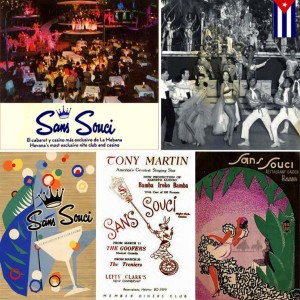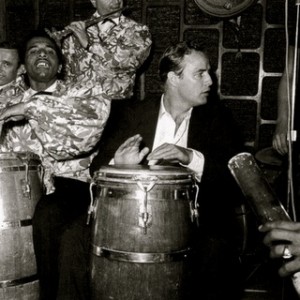CUBA MEMORIES: THE LUXURIOUS ” SANS SOUCI” CABARET, HAVANA.
It owes its name to ‘Sanssouci’, which was the former summer palace of Frederick the Great, King of Prussia, in Potsdam, near Berlin. “Sanssouci” is a French term which translates as “carefree”, symbolizing that the palace was rather a place of rest and not a power center. The same thought the founders of Sans Souci in Havana, because they wanted all visitors feel at home, away from the worries.
The cabaret-casino Sans Souci, was in Arroyo Arena Km.15. It was founded in the days following the First World War. It became one of the most popular places in the world and never-from its opening until 1959 was completely closed, although the repeal and the Great Depression reduced its operation when the tourist trade declined.
Although I do not know to most of the owners, yes I can tell you that Norman Rothman was his manager a season, and Olga Chaviano was the undisputed star from 1953-1955 who became pregnant and had her first child with Rothman in 1956.
In 1955 Miami Lefty Clark, who operated some of the best holiday casinos in Florida, was his new manager. Clark and his associates spent a million dollars on the refurbishment of the club, which ended in 1957. Establishing a rural setting and architecturally an old Spanish villa and modern slot machines coating the walls and halls.
Lefty Clark also practically rebuilt and expanded the Sans Souci. After his speech would sit easily 1,100 customers. And something like Tropicana, we added a glass ceiling, for the nights of rain or bad weather.
Sua game rooms had the usual roulette tables, craps, blackjack and chemin de fer (known as “shimmies” in the market for gambling). Inside was the “Nevada Cocktail Lounge”, which had its own show independent of the show’s main hall.
Loving the big shows, Clark offered to former heavyweight boxing champion Rocky Marciano’s figure of $ 350,000 for a fight against the Cuban challenger Child Valdés at the club, and treated with international figures like Marlene Dietrich, Liberace and Susan Hayward, that take charge of entertainment 1957-58 season.
The new administration in 1955, considered renaming Sans Souci possibly Copacabana or Copahabana, to get away from the previous bad reputation that had the club on the basis of the game, but ultimately felt that the name of Sans Souci was a milestone Havana, and that the best way to restore respectability would simply operate respectably. Already in 1956, the Sans Souci was considered the number three in all Cuba by the “Cabaret Havana Guide 1956”.
Sans Souci was so important producing his own records with the music that was played at their shows. With this production the D’Aida quartet made its first recording and Ernesto Aquino, virtuoso violinist, composer and conductor.
After remodeling the Sans Souci took excellent effect and elaborate shows with unique choreographies of the master teacher Alberto Alonso, putting it on par with Tropicana.
Among foreign personalities who encouraged in this cabaret, we highlight the Americans Tony Martin, Frank Sinatra, Kirk Douglas or Nat King Cole and characters like Mario Moreno (Cantinflas), Rocky Marciano or Libertad Lamarque. The debut of our great nightclubs Rosita Fornes would in the cabaret Sans Souci, in La Lisa, at the beginning of the 40s.
The prestigious “Cuervo y Sobrino” designed some exclusive watches watches for Sans Souci manufactured in Switzerland with 16 jewels. This company was founded in Cuba in 1882 and grew into the 1940s in a strong opponent of prestigious watchmakers in New York, France and Italy.
And another curiosity: Marlon Brando, in his first Havana night was the cabaret Sans Souci to meet his friend singer and actress Dorothy Dandridge who acted in the cabaret Sans Souci ….
Agencies/MemoriasdeCuba/Derubín Jacomé/InternetPhotos/Arnoldo Varona/thecubanhistory.com
THE CUBAN HISTORY, HOLLYWOOD.
FOLLOW US ON TWITTER AND FACEBOOK. THECUBANHISTORY.COM
MEMORIAS DE CUBA: EL LUJOSO CABARET “SANS SOUCI”, HABANA.
Debe su nombre al ‘Sanssouci’, que era el palacio de verano oficial de Federico II el grande, Rey de Prusia, en Potsdam, cerca de Berlín. “Sanssouci” es un término francés que puede traducirse como “sin preocupaciones”, simbolizando que el palacio era más bien un lugar de descanso y no un centro de poder. Lo mismo pensaron los fundadores del Sans Souci en La Habana, porque ellos querían que todos los visitantes se sintieran como en su casa, alejados de las preocupaciones.
El cabaret-casino “Sans Souci”, estaba en Arroyo Arena Km.15. Fue fundado en los días siguientes a la I Guerra Mundial. Llegó a ser uno de los lugares más populares del mundo y nunca –desde su inauguración hasta 1959- fue totalmente cerrado, aunque la derogación y la gran depresión redujo su funcionamiento cuando el comercio turístico disminuyó.
Aunque desconozco a todos sus propietarios, sí puedo comentarles que Norman Rothman fue su gerente una temporada, y que Olga Chaviano fue la indiscutible estrella desde 1953 a 1955 que salió embarazada y tuvo a su primer hijo con Rothman en 1956.
En 1955 Lefty Clark de Miami, quien operaba algunos de los mejores casinos vacacionales de Florida, fue su nuevo administrador. Clark y sus asociados gastaron un millón de dólares en el reacondicionamiento del club, que terminaron en 1957. Estableciendo en un entorno rural y arquitectónicamente una villa española antigua, y unas modernas máquinas tragamonedas revistiendo sus paredes y salones.
Lefty Clark prácticamente reconstruyó y además amplió el Sans Souci. Después de su intervención se sentaban fácilmente 1.100 clientes. Y algo similar a Tropicana, le adicionaron un techo de cristal, para las noches de lluvia o mal tiempo.
Sua salones de juego contaban con las habituales mesas de ruleta, craps, black-jack y chemin de fer (conocida como “shimmies” en el mercado de juegos de azar). En el interior estaba el “Nevada Cocktail Lounge”, que tenía su propio espectáculo independiente del show de la sala principal.
Amante los grandes espectáculos, Clark ofreció al ex campeón de boxeo peso heavyweight Rocky Marciano la cifra de 350.000 dólares por una pelea contra el retador cubano Niño Valdés en el club, y trató con figuras internacionales como Marlene Dietrich, Liberace y Susan Hayward, para que se encargaran del entretenimiento de temporada de 1957-58.
La nueva administración, en 1955, consideró cambiar el nombre de Sans Souci posiblemente por Copacabana o Copahabana, a fin de alejarse de la mala reputación anterior que tuvo el club por motivos del juego, pero finalmente consideraron que el nombre de Sans Souci era un hito de La Habana, y que la mejor manera de restaurar la respetabilidad sería simplemente operar de forma respetable. Ya en 1956, el Sans Soucí fue considerado el número tres de toda Cuba por el “Cabaret Guide Havana 1956”.
Sans Souci era tan importante que producía sus propios discos con la música que se interpretaba en sus shows. Con esta productora el cuarteto las D’Aida hizo su primera grabación y también Ernesto Aquino, virtuoso violinista, compositor y director de orquesta.
Después de remodelado el Sans Souci se llevaron a efecto excelentes y elaborados shows con coreografias exclusivas del magistral maestro Alberto Alonso, poniéndolo a la par de Tropicana.
Entre las personalidades extranjeras que animaron en este cabaret, podemos destacar a los norteamericanos Tony Martín, Frank Sinatra, Kirk Douglas o Nat King Cole y personajes como Mario Moreno (Cantinflas), Rocky Marciano o Libertad Lamarque. El debut en centros nocturnos de nuestra gran Rosita Fornés lo haría en el cabaret Sans Souci, en La Lisa, a principio de la década del 40.
La prestigiosa marca de relojes “Cuervo y Sobrino” diseñó unos relojes exclusivos para el Sans Souci fabricados en Suiza con 16 joyas. Esta compañía fue fundada en Cuba en 1882 y llegó a convertirse en la década de 1940 en un fuerte rival de prestigiosos relojeros de New York, Francia e Italia.
Y otra curiosidad: Marlon Brando, en su primera noche habanera fue al cabaret Sans Souci para encontrarse con su amiga la actriz y cantante Dorothy Dandridge que actuaba en el cabaret en esos dias…
Agencies/MemoriasdeCuba/Derubín Jacomé/InternetPhotos/Arnoldo Varona/thecubanhistory.com
THE CUBAN HISTORY, HOLLYWOOD.











